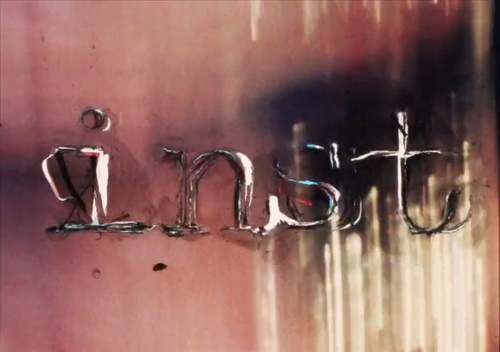
The films of Turkish-American artist Nazlı Dinçel can provoke a high degree of discomfort for a viewer, but that is only the beginning. While there are several varieties of provocation within Dinçel’s arsenal, it’s the explicit sexuality that has already begun to make her work notorious, tearing at the straitjacket of decorum. But Dinçel provokes audiences only for good reasons: there are radical politics at work in these films, and only sometimes is sexual explicitness invoked for this achievement.
The first works in Dinçel’s filmography appear in 2009; though she considers some of these early films student work or mere formal studies, they display notable precision with nods to filmic methods pioneered by the likes of Maya Deren (2009’s Updown), Ken Jacobs (Reframe), and Man Ray (2010’s Interval). Dinçel’s first “official” film, Leafless (2011), displays some early indications of the rougher, handcrafted style that would come to characterize her best-known work. A study of natural and human-made surfaces, Leafless juxtaposes tree bark and rumpled blankets with the smooth contours of hands, arms and less immediately identifiable body parts. Throughout, the film is saturated with the warm yellow-orange glow that is the dominant hue in Dinçel’s subsequent films. A tender meditation on the landscape of a lover’s body, Leafless provides a small taste of Dinçel’s cinematic engagement with the flesh.

It was with 2014’s Her Silent Seaming that experimental film programmers more widely took note of Dinçel. A three-part film, Her Silent Seaming is presented as a series of confessions or journal entries about highly problematic sexual encounters. In it, protagonist “Naz” provides unflattering portraits of three former lovers, their words scratched into the emulsion one at a time. It is not so much the frankness that makes Her Silent Seaming such an uncomfortable sit as it is Dinçel’s use of these “sensitive” men’s own words to indict them. One man tells Naz “I WANT YOU TO COME.” In context, it is clear that this is less the desire of a generous lover than the mewling insecurity of a little boy. Dinçel scratches these and other words into the emulsion multiple times, the frame filling with rows of a single emphatic plea.
Within Her Silent Seaming, the filmmaker’s now-characteristic style and aesthetic take shape. The film makes use of scratched-in text, performative gestures, and a rough physical substrate that gives the filmstrip the likeness of an excavated artifact. Together, these elements produce a discomfiting affect for the viewer, giving the sense that she or he is peeking at a lost diary or examining an object not entirely meant for public consumption.
Most of Dinçel’s works from this point forward contain elements that are framed as autobiographical, both in their use of the rhetorical form of confession and in the occasional third-person-indirect hailing of a person called “Naz.” Dinçel’s films, then, possess all the signposts of confessional art – compare them with the poems of Sylvia Plath or the early videos of Sadie Benning – and ask to be read that way. But of course, we must address them with the knowledge that Dinçel may always be fashioning a discursive fiction.

Dinçel’s formal and discursive strategies achieve their fullest expression in her next three films, Solitary Acts #4, #5, and #6[i] which are her most sexually explicit films to date. Solitary Acts #4 begins with a blurry, abstracted image. Dinçel can be heard on the soundtrack reading single words and word fragments as they appear on the screen: “she locks the bathroom door – she rubs the shower head against her – against herself – against her clit.” Her language follows the film’s visual pattern, becoming increasingly more confident in its explicitness. The image comes into focus, and we see a close-up of Dinçel masturbating. In Solitary Acts #5, Dinçel tells more than she shows, presenting a word-by-word account of penetrating herself with a carrot. At the film’s end, Dinçel’s grandmother tells her: “You will not make a good Muslim.”
Prevailing concepts of religion and shame are carried into more abstract, surrealist territory in #6, which addresses the aftermath of an abortion. Here, Dinçel reappears on the soundtrack describing a dream or fantasy in which the aborted child lives and becomes her male lover. Described by Dinçel as her feminist critique of Freud’s Oedipus complex[ii], the film consists mostly of a close-up of a masturbating male in a sort of rhyme or opposition with #4.
While there is no doubt that the close-up view of masturbation is a surprising cinematic sight, it is vital that these elements of Dinçel’s cinema be considered with critical breadth. As a woman and an immigrant from a Muslim-majority country, Dinçel is perhaps subject to certain cultural assumptions and (mis)conceptions about sexuality, modesty, and autonomy that the Western gaze may ascribe to her, both as an artist and an embodied subject, limiting readings of her vision in the Western critical context. More significant, and less reductive, is the fact of Dinçel’s participation in a cinematic tradition that operates at the intersection of high art and sexual explicitness, a tradition well established within the avant-garde.

We can see the influences of other now-canonical filmmakers – Jack Smith (by Dinçel’s own admission)[iii], Andy Warhol, Stan Brakhage, Su Friedrich, Luther Price – who have worked with explicit images in their art and produced their own share of discomfort over the years. So even though there is considerably more to Dinçel’s cinema than close-ups of genitalia, the films that do contain those elements ought to be considered more than mere provocation: they are strategic interventions of sorts, bringing sexual bodies into a space where they still have the power to be disruptive. Dinçel’s cinema uses sexuality as feminist expression, but also as institutional critique.
One needs no further proof of this aspect of Dinçel’s work than her 2016 untitled video work, which premiered at Toronto’s 2017 Images Festival. An eye-opening piece of guerilla counter-surveillance, untitled documents Dinçel’s time working as a tech assistant at a film festival where she managed to record the headset chatter between herself and the two male projectionists working the event. Over the course of 12 short minutes, we hear the men continually berate Dinçel, ignoring her specific knowledge of film and dismissing her when she correctly diagnoses technical problems. The subtext is blaring: shut up, little girl! We guys will handle this. Seen in the context of a still-evolving body of work, a piece like untitled makes it clear that, far from being a provocateur or attention-seeker, Dinçel is dedicated to exploring, and challenging, one of the most fundamental inequities: what does it take for a young woman to be heard?
The cinema of Nazlı Dinçel is historically grounded, built from some of the sturdiest traditions in the avant-garde. While many younger filmmakers turn to the internet or other digital media for inspiration, Dinçel understands that the physicality of film offers a hard analogue for problems of embodiment, a set of experiences that we cannot avoid because we hold them closest to us. Dinçel presents one definitive way forward in experimental film and offers an alternate model of the millennial filmmaker: corporeal, intersectional, historically aware, not seduced by the shiny neoliberal promises of consumer desires or cyberspace.[iv] Dinçel has moved through various discursive forms to rejoin us here, face to face. To fail to meet her in the name of propriety is our loss.
Michael Sicinski is a contributor to Cinema Scope, Cargo, Mubi, and others.





